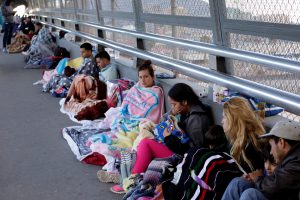
By Steve Holland and Ginger Gibson
WASHINGTON (Reuters) – The U.S. economy is taking a larger-than-expected hit from the partial government shutdown, White House estimates showed on Tuesday, as congressional Democrats rejected President Donald Trump’s invitation to discuss the issue.
The shutdown dragged into its 25th day on Tuesday with neither Trump nor Democratic congressional leaders showing signs of bending on the topic that triggered it – funding for the wall Trump promised to build along the border with Mexico.
Trump invited a bipartisan group of members of Congress for lunch at 12:30 p.m. EST (1730 GMT) to discuss the standoff but the White House said Democrats turned down the invitation. Nine Republicans were expected to attend.
Trump is insisting Congress shell out $5.7 billion as about 800,000 federal workers go unpaid during the partial shutdown.
“It’s time for the Democrats to come to the table and make a deal,” said White House spokeswoman Sarah Sanders.
House Democratic leaders said they did not tell members to boycott Trump’s lunch but had pressed those invited to consider whether the talks would be productive or produce a photo-op for the president.
“We are unified,” House Majority Leader Steny Hoyer told reporters on Tuesday morning.
The Trump administration had initially estimated the shutdown would cost the economy 0.1 percentage point in growth every two weeks that employees were without pay.
But on Tuesday, there was an updated figure: 0.13 percentage point every week because of the impact of work left undone by 380,000 furloughed employees as well as work left aside by federal contractors, a White House official said.
SHUTDOWN IMPACT
The partial shutdown is the longest in U.S. history and its effects have begun to reverberate across the country.
Longer lines have formed at some airports as more security screeners fail to show up for work while food and drug inspections have been curtailed and farmers, stung by recent trade spats, have been unable to receive federal aid.
Speaking on CNBC, Delta Air Lines Inc Chief Executive Officer Ed Bastian said the partial shutdown will cost the airline $25 million in lost revenue in January because fewer government contractors are traveling.
Trump ran for office in 2016 on a promise to build a wall to stop illegal immigration and drug trafficking. He had toyed with the prospect of declaring a national emergency to circumvent Congress to secure the funding, but this week has backed off from that idea, which would attract a court challenge.
Democrats, who took over the U.S. House of Representatives this month, have rejected the border wall but back other border security measures.
They have also insisted that Trump and Republicans reopen government before negotiations occur.
“We can keep on the pressure on negotiations over (border) security but it is long past time that we reopen the government, and make sure it is not federal employees, their families and businesses that are being held hostage,” said Democrat Representative Katherine Clark.
House Democrats have passed a number of bills to fund the roughly one-quarter of federal operations that have been closed, but Senate Majority Leader Mitch McConnell, a Republican, has said the chamber will not consider legislation that Trump will not sign into law.
McConnell, who has mainly stayed out of the public fray on the shutdown, on Tuesday accused Democrats of “acrobatic contortions” to avoid negotiating on the shutdown.
(Reporting by Steve Holland, Susan Cornwell, Ginger Gibson, Makini Brice, Susan Heavey; Writing by Roberta Rampton; Editing by Steve Orlofsky and Bill Trott)




